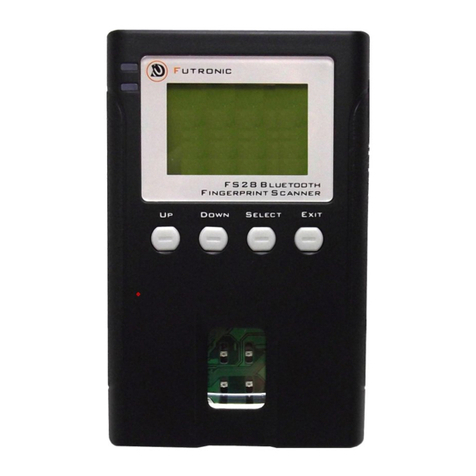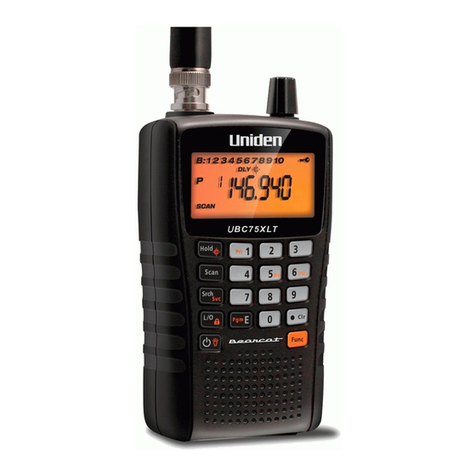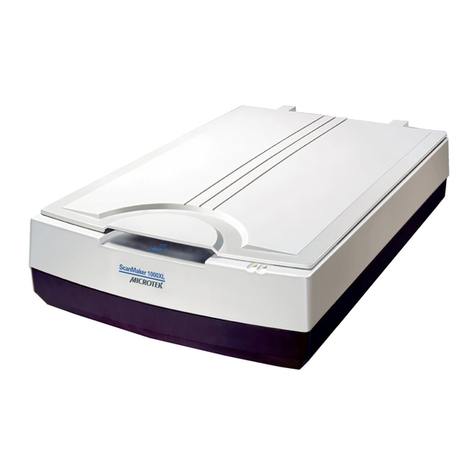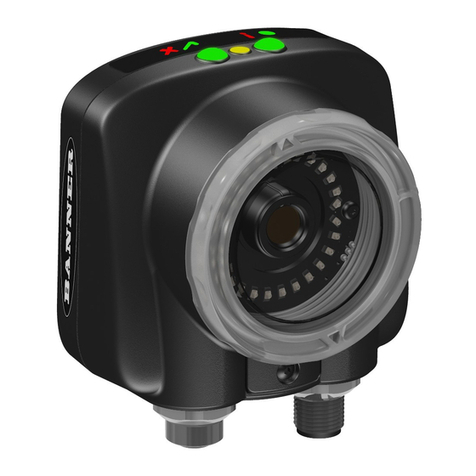PPI ScaneXPlus User manual

Multi-Channel Universal
Process Value Scanner with
Common High / Low Alarms
User Manual
Scane Plus

1. PANEL MOUNTING AND ELECTRICAL CONNECTIONS 1
2. FRONT PANEL LAYOUT 4
3. BASIC OPERATION 6
4. SET UP MODE : ACCESS AND OPERATION 9
5. CONFIGURATION PARAMETERS 11
6. ALARM CONFIGURATION PARAMETERS 18
7. ALARM SETTING PARAMETERS 19
APPENDIX-A : DC LINEAR SIGNAL INTERFACE 21
APPENDIX-B : BOTTOM / TOP CLIPPING 23
CONTENTS
User Manual
SCANEX PLUS

1
WARNING
MISHANDLING / NEGLIGENCE
CAN RESULT IN PERSONAL DEATH
OR SERIOUS INJURY.
PANEL MOUNTING AND ELECTRICAL CONNECTIONS
PANEL CUTOUT
PANEL MOUNTING
Follow the steps below for mounting the instrument on panel :
1. Prepare a cutout to the size shown in Figure 1.1.
2. Remove the Panel Mounting Clamp from the instrument Enclosure.
3. Insert the rear of the enclosure through the panel cutout from the front of the mounting panel.
4. Fix the mounting clamp pair such that it ensures secured mounting of the enclosure against the panel wall.
ELECTRICAL CONNECTIONS
Observe the followings while making electrical connections.
1. Run power supply cables separated from sensor (Thermocouple/RTD/mA/mV/V) cables. If the cables are run through
conduits, use separate conduits for power supply cable and sensor cables.
2. Use appropriate fuses and switches, wherever necessary, for driving the high voltage loads to protect the instrument from
any possible damage due to high voltage surges of extended duration or short-circuits on loads.
3. Switch-off the power supply while making / removing any connections.
The Figure 1.2(a) & Figure 1.2(b) show the terminals viewed from the rear side, with the scanner label upright, for 8 Channel &
16 Channel versions, respectively.
Panel Cutout
92 X 184 mm
-0, +0.5 mm
Figure 1.1
Figure 1.2(a) : 8 Channel
User Manual
SCANEX PLUS
Section 1
71 72 73 74 75 76 77 78
C NO C NO C NO C NO
RLY-1 RLY-2 RLY-3 RLY-4
Alarm Outputs
AI-1 AI-3 AI-5 AI-7
AI-4 AI-6 AI-8
12345678910 11 12 13 14 15 16
AI-2
35 36 37 38 39 40 41 42 43 44 45 46 47 48 49 50 67 68
+
-
RS485
OUT
69 70
L N
Supply
85~264VAC
33 34
+
-
RS485
IN
AI - X
RTD
TC
V/mV
mA

2
User Manual
SCANEX PLUS
AI - X
mV / V
T1 T2 T3 T4
T1 T2 T3 T4
INPUT CHANNELS
All input channels are identical from wiring connection viewpoint. For explanation purpose, the 4 terminals pertaining to each
channel have been marked as T1, T2 ,T3 & T4 in the following pages. The descriptions below apply to all the channels with no
deviations.
Thermocouple
Connect Thermocouple Positive (+) to terminal T2 and Negative (-) to terminal T3 as shown in
Figure 1.3. Use the correct type of Thermocouple extension lead wires or compensating cable for
the entire distance ensuring the correct polarity throughout. Avoid joints in the cable.
AI - X
TC
T1 T2 T3 T4
T1 T2 T3 T4
AI - X
RTD
T1 T2 T3 T4
T1 T2 T3 T4
DC Linear Voltage (mV / V)
Use a shielded twisted pair with the shield grounded at the signal source for connecting mV / V
source. Connect common (-) to terminal T3 and the signal (+) to terminal T2, as shown in Figure
1.5.
RTD Pt100 (3-wire or 2-wire)
For 3-wire configuration, connect single leaded end of RTD bulb to terminal T2 and the double
leaded ends to terminals T3 and T4 (interchangeable) as shown in Figure 1.4. Use copper
conductor leads of very low resistance ensuring that all 3 leads are of the same gauge and length.
Avoid joints in the cable.
For 2-wire configuration, connect the 2 sensor wires to terminal T2 and T3 (interchangeable). Also
short terminals T3 & T4.
Figure 1.3
Figure 1.4
Figure 1.5
AI - X
mA
T1 T2 T3 T4
T1 T2 T3 T4
DC Linear Current (mA)
Use a shielded twisted pair with the shield grounded at the signal source for connecting mA source.
Connect common (-) to terminal T3 and the signal (+) to terminal T2. Also short terminals T1 & T2.
Refer Figure 1.6.
Figure 1.6
71 72 73 74 75 76 77 78
C NO C NO C NO C NO
RLY-1 RLY-2 RLY-3 RLY-4
Alarm Outputs
AI-1 AI-3 AI-5 AI-7 AI-9 AI-11 AI-13 AI-15
AI-4 AI-6 AI-8 AI-10 AI-12 AI-14 AI-16
1 2 3 4 5 6 7 8 9 10 11 12 13 14 15 16 17 18 19 20 21 22 23 24 25 26 27 28 29 30 31 32
AI-2
35 36 37 38 39 40 41 42 43 44 45 46 47 48 49 50 51 52 53 54 55 56 57 58 59 60 61 62 63 64 65 66 67 68
+
-
RS485
OUT
69 70
L N
Supply
85~264VAC
33 34
+
-
RS485
IN
AI - X
RTD
TC
V/mV
mA
Figure 1.2(b) : 16 Channel

3
User Manual
SCANEX PLUS
Figure 1.8
Line
Neutral
2 Pole
Isolating Switch
Fuse
Power Supply Terminals
69
70
L
N
As standard, the module is supplied with power connections suited for 85 to 264 VAC line supply. Use well-insulated copper
conductor wire of the size not smaller than 0.5mm² for power supply connections ensuring proper polarity as shown in Figure
1.8. The module is not provided with fuse and power switch. If necessary, mount them separately. Use a time lag fuse rated 1A
@ 240 VAC.
POWER SUPPLY
RELAY OUTPUTS
There are 4 Relay Outputs provided for common alarms. The relay connections are shown in Figure 1.7 below.
Figure 1.7
Potential-free Relay changeover contacts NO (Normally
Open) and C (Common) rated 10A/240VAC (resistive
load) are provided as Relay output.
AC
LOAD
Relay Output Terminals
NO
C
DC

4
Indicator Function
MANUAL
ALARMS
(1 to 16)
Glows ON when the Scanner is put in Manual Scan Mode.
Flashes if the corresponding channel is in Alarm condition.
Table 2.1
FRONT PANEL LAYOUT
The front panel comprises of digital readouts, LED indicators and membrane keys as shown in Figure 2.1 below.
READOUTS
The PV Readout is a 5 digit, 7-segment bright red LED display that displays the PV (Process Value). In Set-up Mode, the PV
Readout displays parameter values/options.
The Channel No. Readout is a 2 digit, 7-segment bright red LED display that shows the Channel No. for which the PV Readout
shows the PV. In Set-up Mode, the Channel No. Readout remains blank.
The Unit Readout is a 4 digit, 7-segment bright green LED display and usually displays the ‘Unit’ pertaining to the PV Readout.
In Set-up Mode, the Unit Readout displays parameter name (prompts).
INDICATORS
There is a single 3 mm red LED indicator that shows the Auto/Manual Scan Mode Status. A group of 16 red LEDs show the
Alarm Status for each of 16 channels. Refer table 2.1 below.
User Manual
SCANEX PLUS
Figure 2.1
Alarm Status
Indicators
ALARMS
Auto / Manual Key
Alarm Ack/View Key
ENTER Key
UP Key
DOWN Key
PAGE Key
Auto/Manual Scan
Mode Indicator
Channel No. Readout
Unit Readout
Scane Plus
MANUAL
PV Readout
Section 2

5
Press to enter / exit Set-up Mode
Press to decrease the parameter value. Pressing once
decreases the value by one count; holding the key pressed
speeds up the change.
PAGE
DOWN
Symbol Function
Press to store the set parameter value and to scroll to the next
parameter.
Press to Acknowledge any pending Alarm(s) and to View details
of the channels under Alarm.
Press to toggle between Auto and Manual Scan Mode. In Manual
Scan Mode, Use UP / DOWN keys to the desired channel.
Key
Press to increase the parameter value. Pressing once increases
the value by one count; holding the key pressed speeds up the
change.
UP
ENTER
Alarm
Ack/View
Auto /
Manual
User Manual
SCANEX PLUS
Table 2.2
KEYS
There are six tactile keys provided on the front panel for setting-up the parameter values and for other functions & commands.
The Table 2.2 below lists each key and the associated function.

6
POWER-UP
Upon switching on the power to the unit, all displays and indicators are lit on for approximately 3 seconds during which time the
Scanner runs a self initialization sequence.
MAIN DISPLAY MODE
After the self initialization sequence, the Scanner enters MAIN Display Mode. The PV Readout starts showing the measured
PV (Process value) with the corresponding channel number being shown on the Channel No. Readout. The MAIN Display
Mode is one that shall be used most often.
The Scanner may be configured to operate in either Auto or Manual Scan Mode. The Power-on default mode is ‘Auto Scan
Mode’. Use front panel key ‘A/M’ to toggle between the Auto and Manual Scan Mode.
Auto Scan Mode
In this mode, the Scanner shows the Process Value for each channel sequentially at a periodic interval, called ‘Scan Rate’.
The Scan Rate is user settable from 1 to 99 seconds. The channels are displayed in ascending (increasing) order with the last
channel automatically rolling over to the first channel. In Auto Scan Mode, the front indicator marked ‘MANUAL’ remains OFF.
Manual Scan Mode
In this mode, the Scanner keeps displaying the Process Value for the selected channel indefinitely. The user can switch to and
hold any desired channel by using UP/DOWN keys. In Manual Scan Mode, the front indicator marked ‘MANUAL’ is lit ON.
ALARM SYSTEM
There are up to 4 soft Alarms (AL-1 to AL-4) available for each channel.
Status Indication
There are 16 front panel Alarm Status LEDs, one for each channel. If any one or more set Alarm for a channel is active, the
corresponding front panel indicator flashes.
Relay Activation & Acknowledge
The 4 Relay Outputs (RLY-1 to RLY-4) are mapped with the 4 Alarms (AL-1 to AL-4) as explained below in Table 3.1.
User Manual
SCANEX PLUS
Section 3
BASIC OPERATION
Output Relay Activation
RLY-1 If Alarm-1 for any one or more channels is ON
If Alarm-2 for any one or more channels is ON
If Alarm-3 for any one or more channels is ON
If Alarm-4 for any one or more channels is ON
Associated Alarm
AL-1
RLY-2 AL-2
RLY-3 AL-3
RLY-4 AL-4
Table 3.1
The front panel Alarm Ack/View key is used to mute the Audio Alarm or to bring the system out of Trip Condition. The effect of
acknowledge function depends both on the Relay Logic (Direct / Reverse) and Latched / Un-Latched operation. Note that
Acknowledging the alarm only de-activates the relay output and does not remove the Alarm condition. Refer Table 3.2 for
effect of Acknowledge Key.

7
Relay Logic Effect of Acknowledge Key
Direct
(Alarm) Switches OFF the Alarm output
No effect
Switches OFF the Alarm output provided no Alarm condition is pending
Switches ON the Trip relay (brings out of tripping) provided no Alarm condition is
pending
Latched
No
Reverse
(Trip) No
Yes
Yes
Direct
(Alarm)
Reverse
(Trip)
Table 3.2
PV ERROR INDICATION
In case the PV falls below the Minimum Range or rises above the Maximum Range specified for the selected ‘Input Type’ or in
case the input sensor is open / broken; the PV Readout flashes the error messages listed in Table 3.3 below. The Figure 3.2
illustrates an open sensor condition for channel-14, for example.
Message PV Error Type
Over-range
(PV above Max. Range)
Under-range
(PV below Min. Range)
Open
(Sensor open / broken)
Table 3.3
Figure 3.2
ALARMS
Scane Plus
Manual
User Manual
SCANEX PLUS
Detail Alarm View
Pressing the Alarm Ack/View key also provides complete Alarm status information for the channels under alarm condition. The
information available is for view only. The Unit Readout indicates the ‘Channel Number’ under Alarm and the corresponding
‘Alarm Number(s)’ are indicated on the PV Readout. The UP/DOWN keys can be used to scroll through all the channels under
Alarm.
The example Figure 3.1 below illustrates the following case :
Channel-2 and Channel-12 are currently under Alarm condition. The active Alarms for Channel-2 are Alarm-1 and Alarm-4
while for Channel-12 it is only Alarm1.
MAIN Display
Mode
Figure 3.1
Press UP / DOWN key
to view next / previous channel
in alarm condition
MAIN Display
Mode
Press ALARM
ACK/VIEW key
Press PAGE or ENTER
key to return to
Main Display Mode
Alarm View
Mode
Alarm View
Mode

8
User Manual
SCANEX PLUS
Table 3.4
Parameter Description Settings
(Default Value)
OPERATOR PAGE & PARAMETERS
The Operator page contains the parameters that are used most frequently and the commands that are required for day-to-day
operation. This page is not locked for editing by Master Lock. The Figure 3.2 below illustrates how to access Operator Page
(Page 0).
RESET COMMAND
This feature clears the current Min/Max values of all Channels and
starts afresh monitoring the channels for new highest and lowest
values.
For resetting, set the reset command to ‘Yes’.
View Only
(Default : NA)
MINIMUM PV
The minimum PV attained by the selected channel.
View Only
(Default : NA)
MAXIMUM PV
The maximum PV attained by the selected channel.
No
Yes
(Default : No)
1 to Actual no. of
Channels to Scan
(Default : 1)
CHANNEL NUMBER
Select the channel No. whose Min/Max PV is to be viewed.
This Parameter reappears cyclically after viewing Max/Min Values
for each selected channel number.
1 Sec. to 99 Sec.
(Default : 3 Sec.)
SCAN RATE
Applicable for Auto Scan Mode only. This parameter value sets the
time interval for which each channel is displayed. In other words,
the rate at which the channels are sequentially updated for
indication.
The Operator Page parameters are listed in Table 3.4 below.
Figure 3.2
Operator Page First Parameter
on Operator
Page
Press PAGE
key to enter
Set-up mode
Press ENTER
key to open
Operator Page
MAIN Display
Mode

9
SET UP MODE : ACCESS AND OPERATION
There are many user settings that determine how the instrument will function or operate. These setting are called Parameters.
For the convenience and ease of operation, the various parameters have been grouped separately depending upon the
functions they define. Each such group is called a PAGE. Each PAGE is assigned a unique number, called PAGE NUMBER,
for its access. The parameters contained in a PAGE are presented in a fixed sequence to the user for setting. The user can
access a desired PAGE by entering its PAGE NUMBER and can select and set the desired parameter values.
PARAMETER PROMPTS
Each parameter has an identifying tag, called the Parameter Prompt. While setting parameter values in a PAGE, the
parameter prompt is always displayed on the Unit Readout and its current value is displayed on the PV Readout.
ACCESSING A PAGE
Each PAGE is accessible only from the MAIN Display Mode. That is, from the current PAGE, the user must return to the MAIN
Display Mode before the other PAGE can be accessed.
Figure 4.1 illustrates access to the desired PAGE from MAIN Display Mode.
User Manual
SCANEX PLUS
Section 4
ADJUSTING PARAMETER VALUES
For accessing and adjusting the parameter, one must first open the PAGE containing the parameter.
Figure 4.2 illustrates how to access the desired parameter(s) and adjust the corresponding value(s). The illustration shows
accessing the parameter ‘Alarm Type’ for Alarm-1 of Channel-1 and changing its value from ‘None’ to ‘Process High’. Press
PAGE key to revert to MAIN Mode.
Figure 4.1
Default Page Page Number
Press PAGE
key to enter
Set-up mode
Use UP/DOWN
key to set
Page Number
Press ENTER
key to open
the Page
MAIN Display
Mode
Figure 4.2
Previous set
Alarm Type
Default Alarm
Number
Press & Release
ENTER Key
to select Channel-1
Use UP/DOWN
keys to set the
desired Value
First Parameter
on PAGE-10
Press & Release
ENTER Key
to select Alarm-1
First Parameter
on PAGE-10

10
PARAMETER LOCKING
For protecting the parameter values from unauthorized / accidental alterations, the parameter adjustments can be Locked.
The Operator Page is not affected by locking. The Figure 4.3 illustrates the steps for Locking.
For Un-Locking, repeat the sequence of steps shown in Figure 4.3 twice.
SETTING DEFAULT VALUES
The instrument is shipped from the factory with all the parameters set to their default values. Refer Figure 4.4 below for
regaining the factory default values.
User Manual
SCANEX PLUS
Figure 4.4
Default Page
Press PAGE
key to enter
Set-up Mode
Default Code
Use UP/DOWN
keys to set the
‘Default’ Code
Press ENTER key.
Scanner resets and restarts
with default parameter values
MAIN Display
Mode
MAIN Display
Mode
Figure 4.3
Default Page Locking Code
Press PAGE
key to enter
Set-up mode
Use UP/DOWN
keys to set the
‘Locking’ Code
Press ENTER key
to Lock & Return to
MAIN Mode
MAIN Display
Mode
MAIN Display
Mode
Desired Alarm
Type
Next Parameter
Press ENTER key
to store the value &
move to next Parameter

11
RESOLUTION
Set the process value indication resolution (decimal point). All the
resolution based parameters (Alarm setpoint, hysteresis etc.)
then follow this resolution setting.
Refer Table 5.2
(Default : 0.1)
Refer Table 5.2
(Default : Type K)
INPUT TYPE
Refer Table 5.2. Select the Input Type in accordance with the type
of sensor connected to the selected channel.
1 to Actual no. of
channels to scan
(Default : 1)
SELECT CHANNEL FOR CONFIGURATION
Refer Figure 5.1 (a) and 5.1 (b).
COMMON INPUT CONFIGURATIONS
In most applications the Scanner is used to monitor the process
value at different points within a closed space (Chamber, Cold
Room, etc). Thus the type of sensors and also the measurement
resolution and units used are Identical (Common) for all channels.
This parameter facilitates eliminating repetitive settings for
multiple channels in such cases.
Yes : The parameter values for Input type, Resolution and PV
Units are applied to all the channels.
No : The parameter values for Input type, Resolution and PV
Units need to be set independently for each channel.
SENSOR-BREAK PV STATUS
This parameter setting allows user to define the alarm behavior
under Sensor open condition.
UP : Any Alarm set as ‘Process High’ gets activated.
DOWN : Any Alarm set as ‘Process Low’ gets activated.
ACTUAL NUMBERS OF CHANNELS TO SCAN
The numbers of channels actually connected/used for monitoring.
This allows skipping unused channels for scanning. Note that only
consecutive channels, starting from channel-1, must be used.
PAGE 12 : CONFIGURATION PARAMETERS
The configuration parameters are listed in Table 5.1 below and are generally required to be set only at the time of installation.
Set these parameters appropriately based on the types of Thermocouple / Sensor connected and other application needs.
Parameter Description Settings
(Default Value)
Table 5.1
Up Scale
Down Scale
(Default : Up Scale)
1 to Max.
Available
(Default : 8 or 16)
No
Yes
(Default : Yes)
User Manual
SCANEX PLUS
Section 5

12
Parameter Description Settings
(Default Value)
PV UNITS
Select Temperature units in °C or °F for Thermocouple or Pt100
sensor.
For DC Linear input (mA/mV/V), Select appropriate Units from the
list in Table 5.3. Note however that the selected Units are for the
purpose of indication on Lower Readout only.
-1999.9 to 3000.0
(Default : 100.0)
DC RANGE LOW
(Applicable only for DC Linear Inputs)
The process value corresponding to the Signal Low value from the
transmitter. For more Description Refer Appendix-A.
-1999.9 to 3000.0
(Default : 0.0)
Refer Table 5.3
(Default : ºC)
User Manual
SCANEX PLUS
(Default : Disable)
Enable
Disable
BOTTOM CLIPPING ENABLE
(Applicable only for DC Linear Inputs)
Refer Appendix-B.
-1999.9 to Top Clipping
Default: 0.0
BOTTOM CLIPPING
(Applicable only for DC Linear Inputs)
Refer Appendix-B.
SIGNAL HIGH
(Applicable only for DC Linear Inputs)
The transmitter output signal value corresponding to Range High
process value. For more Description Refer Appendix-A.
SIGNAL LOW
(Applicable only for DC Linear Inputs)
The transmitter output signal value corresponding to Range Low
process value. For more Description Refer Appendix-A.
Input Type Settings Default
0 to 20 mA 0.00 to Signal High 0.00
4 to 20 mA
0 to 80 mV
0 to 1.25 V
0 to 5 V
0 to 10 V
1 to 5 V
4.00 to Signal High
0.00 to Signal High
0.000 to Signal High
0.000 to Signal High
0.00 to Signal High
1.000 to Signal High
4.00
0.00
0.000
0.000
0.00
1.000
Input Type Settings Default
0 to 20 mA
4 to 20 mA
0 to 80 mV
0 to 1.25 V
0 to 5 V
0 to 10 V
1 to 5 V
Signal Low to 20.00 20.00
20.00
80.00
1.250
5.000
10.00
5.000
Signal Low to 20.00
Signal Low to 80.00
Signal Low to 1.250
Signal Low to 5.000
Signal Low to 10.00
Signal Low to 5.000
DC RANGE HIGH
(Applicable only for DC Linear Inputs)
The process value corresponding to the Signal High value from
the transmitter. For more Description Refer Appendix-A.

13
User Manual
SCANEX PLUS
Bottom Clipping to 3000.0
(Default : 100.0)
(Default : Disable)
Enable
Disable
TOP CLIPPING ENABLE
(Applicable only for DC Linear Inputs)
Refer Appendix-B.
TOP CLIPPING
(Applicable only for DC Linear Inputs)
Refer Appendix-B.
Parameter Description Settings
(Default Value)
Table 5.2
Resolution
Option What it means Range (Min. to Max. )
Type J Thermocouple
Type K Thermocouple
Type T Thermocouple
0.0 to +960.0°C / +32.0 to +1760.0°F
-200.0 to +1376.0°C / -328.0 to +2508.0°F
-200.0 to +387.0°C / -328.0 to +728.0°F
Type R Thermocouple
Type S Thermocouple
Type B Thermocouple
Type N Thermocouple
0.0 to +1771.0°C / +32.0 to +3219.0°F
1 °C/°F
or
0.1 °C/°F
3-wire, RTD Pt100
-199 to +600°C / -328 to +1112°F
-199.9 to +600.0°C / -328.0 to +1112.0°F
or
1 °C/°F
or
0.1 °C/°F
0.0 to +1314.0°C / +32.0 to +2397.0°F
0.0 to +1826.0°C / +32.0 to +3218.0°F
0.0 to +1768.0°C / +32.0 to +3214.0°F
Reserved for customer specific Thermocouple type not listed
above. The type shall be specified in accordance with the
ordered (optional on request) Thermocouple type.
-1999.9 to 3000.0
(Default : 0.0)
OFFSET
In many application, the measured PV at the input requires a
constant value to be added or subtracted to obtain a final process
value for removing sensor zero error or to compensate known
thermal gradient. This parameter is used to remove such errors.
Actual (Displayed) PV = Measured PV + Offset for PV.

14
User Manual
SCANEX PLUS
0 to 20mA DC current
4 to 20mA DC current
0 to 80mV DC voltage
Reserved
0 to 1.25V DC voltage
0 to 5.0V DC voltage
0 to 10.0V DC voltage
1 to 5.0V DC voltage
-19999 to 30000 units
1
0.1
0.01
0.001
units
Resolution
Option What it means Range (Min. to Max. )
°C
°F
Kelvin
Engineering Units
Percentage
Pascals
Mpascals
Kpascals
Bar
Milli bar
PSI
kg/sq cm
mm water gauge
Inches water gauge
mm mercury
Torr
Unit Readout Units
Table 5.3

15
User Manual
SCANEX PLUS
Liters per hour
Liters per minute
% Relative Humidity
% O2
% CO2
% Carbon Potential
volts
Amps
Milli amps
Milli Volts
Ohms
Parts per million
Revolutions per pinute
Milli seconds
Seconds
Unit Readout Units
Miles per hour
Milli grams
Grams
Kilo grams
Minutes
Hours
PH
%PH

16
Note : Press PAGE Key to Revert to Main Display Mode.
User Manual
SCANEX PLUS
Set Resolution common to all
Channels
Set Unit common to all
Channels
Select Channel for which
Offset value is to be set
Set Offset value for the
selected Channel
Figure 5.1(a)
Set Resolution common to all
Channels
Set Unit common to all
Channels
Set Signal Low
common to all Channels
Set Signal High
common to all Channels
Set DC Range Low
common to all channels
Set DC Range High
common to all channels
Choose
whether Bottom Clipping
to be enabled for
all Channel
Set the Bottom Clipping Value
common to all Channels
Select Channel for which
Offset value is to be set
Set Offset value for the
selected Channel
Select Input Type
All Channel Common = “YES”
For DC Input Type
For Thermocouple/RTD
Input Type
No
Choose
whether Top Clipping
to be enabled for
all Channel
Set the Top Clipping Value
common to all Channels
Yes
Yes
A
A
B
B
No B

17
Figure 5.1(b)
Set Resolution for the
Selected Channel
Set Unit for the Selected
Channel
Set Signal Low
for the Selected Channel
Set Signal High
for the Selected Channel
Set DC Range Low
for the Selected Channel
Set DC Range High
for the Selected Channel
Choose
whether Bottom Clipping
to be enabled for
Selected Channel
Set the Bottom Clipping Value
for the Selected Channel Select Channel for which
Offset value is to be set
Set Offset value for the
selected Channel
Select Input Type
All Channel Common = “NO”
For DC Input Type For Thermocouple/RTD
Input Type
Set the Top Clipping Value for
the Selected Channel
Yes
Yes
User Manual
SCANEX PLUS
Choose
whether Top Clipping
to be enabled for
Selected Channel
Select Channel
D
D
Set Resolution for the
Selected Channel
Set Unit for the Selected
Channel
Select Channel for which
Offset value is to be set
Set Offset value for the
selected Channel
D
No
A
A
B
B
No C
C

18
RELAY LATCH
No : The Relay switches ON or OFF with Alarm activation or de-
activation.
Yes : The Relay Output switches (ON for Normal Logic / Off for
Reverse logic) upon Alarm activation. However, Alarm de-
activation does not affect the Relay status. The Relay
status can only be regained by pressing acknowledge key
provided the Alarm has de-activated.
RELAY LOGIC
Normal : The Relay remains ON under Alarm condition; OFF
otherwise. Useful for activating Audio (like hooter) or
Visual (like lamp) gadget.
Reverse : The Relay remains OFF under Alarm condition; ON
otherwise. Useful for Tripping the system under
monitoring.
1 to No. of
Alarms per channel
(Default : NA)
SELECT OUTPUT RELAY NUMBER
The Scanner features 4 Relay Outputs (RLY-1 to RLY-4) that are
mapped to AL-1 to AL-4 of each channel. The relay outputs can be
used for either activating Audio/Visual gadgets (Normal Logic) or
for Tripping the system being monitored (Reverse Logic). Further
the output can be programmed to either switch ON/OFF with
Alarm switching (Relay Latch = No) or remain Latched until
acknowledged (Relay Latch = Yes).
This parameter allows to select 1 out of 4 Relays for ‘Logic’ and
‘Latch’ parameter setting.
1 to 4
(Default : 4)
NUMBER OF ALARMS PER CHANNEL
The instrument is provided with 4 independently settable soft
Alarms per channel. However, the actual number of Alarms
required per channel may vary from application to application.
This parameter allows selecting the exact number of Alarms
required per channel (Maximum 4).
Normal
Reverse
(Default : Normal)
The parameters presented on this page allow configuring the number of Alarms per channel, the Alarm output function (Audio /
Visual or Tripping) and Alarm latching.
PAGE 11 : ALARM CONFIGURATION PARAMETERS
Parameter Description Settings
(Default Value)
Table 6.1
No
Yes
(Default : No)
User Manual
SCANEX PLUS
Section 6
Table of contents
Popular Scanner manuals by other brands
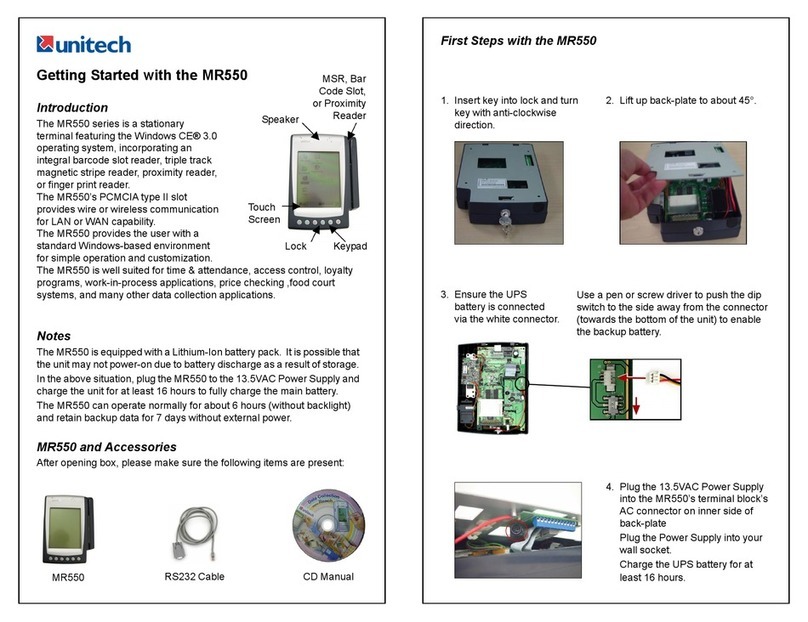
Unitech
Unitech MR550 Getting started guide
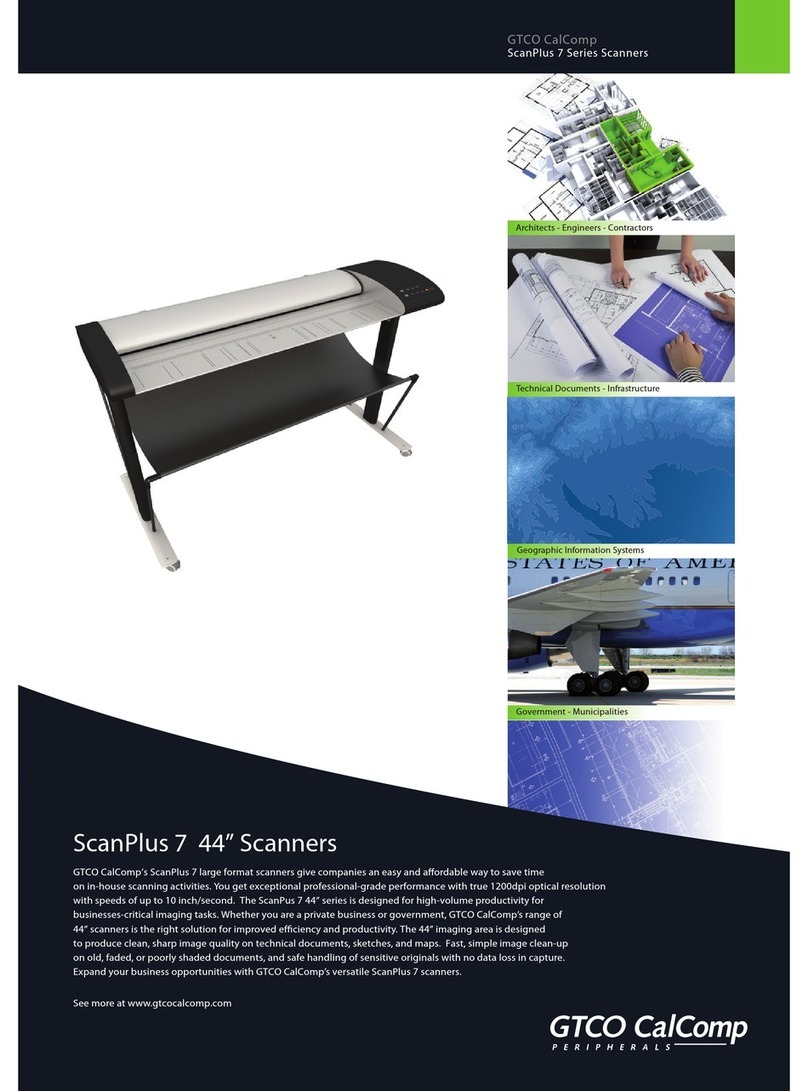
GTCO CalComp
GTCO CalComp ScanPlus 7 ATF1824C Brochure & specs

Smartoptics
Smartoptics Vinyl Series operating manual
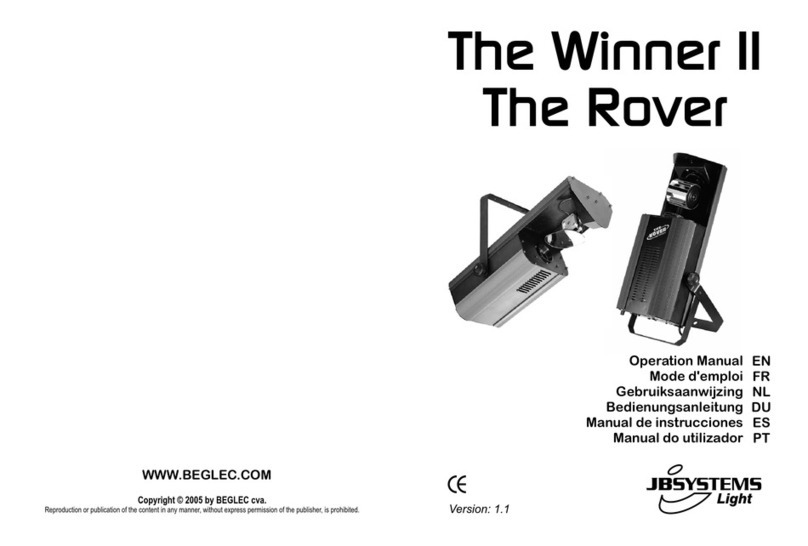
JB Systems Light
JB Systems Light Winner II Operation manual
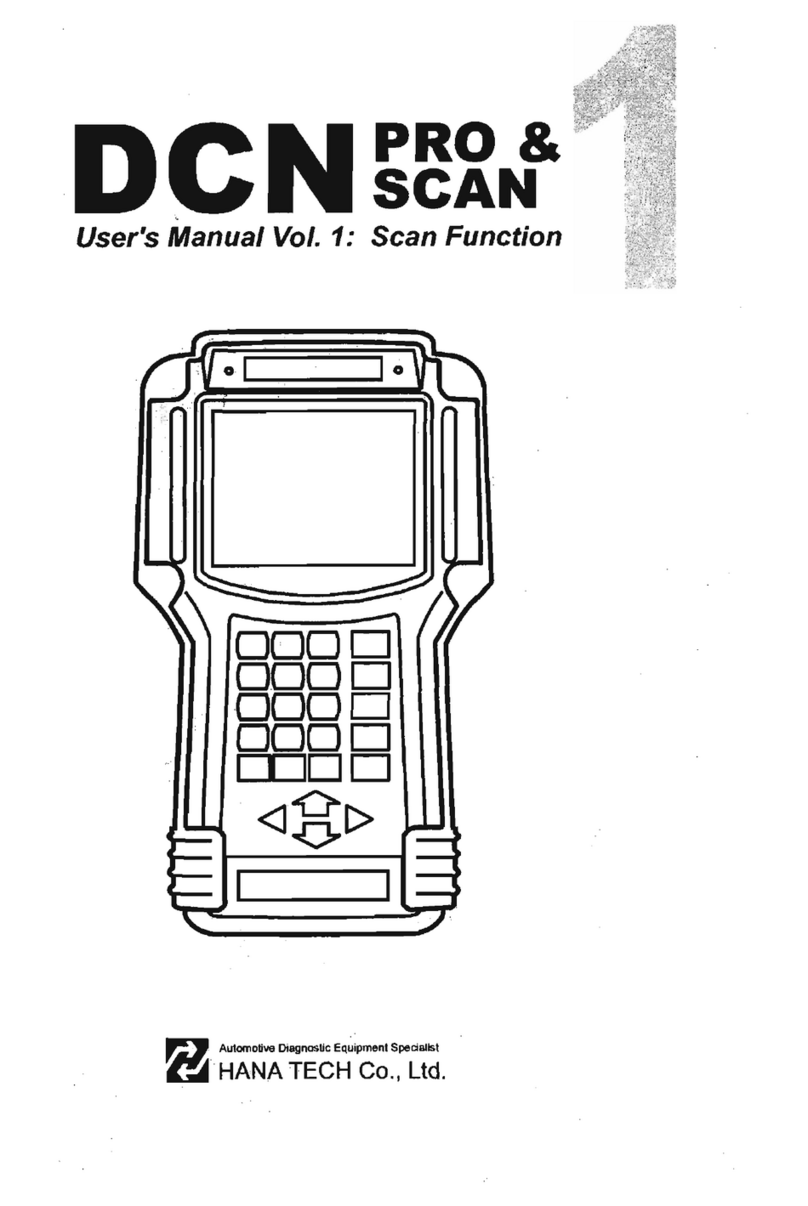
Hanatech
Hanatech DCN PRO & SCAN user manual
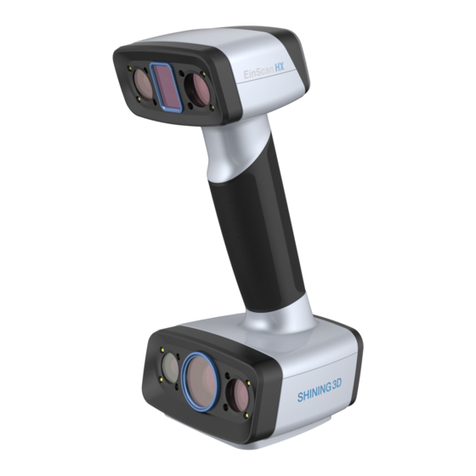
Shining 3D
Shining 3D EinScan HX user manual

rs scan
rs scan iQube mini E100 Installation and user guide

3D Histech
3D Histech Pannoramic SCAN II user guide
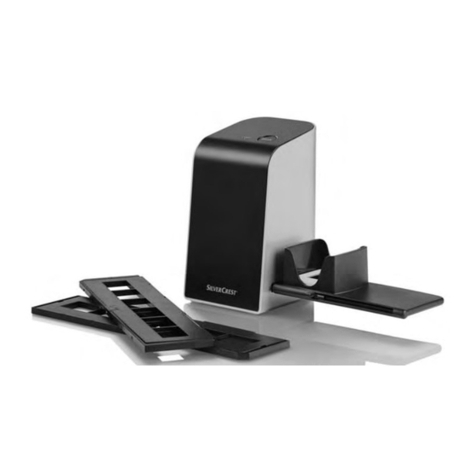
Silvercrest
Silvercrest SND 3600 A2 operating instructions

Silvercrest
Silvercrest SND 3600 A2 operating instructions
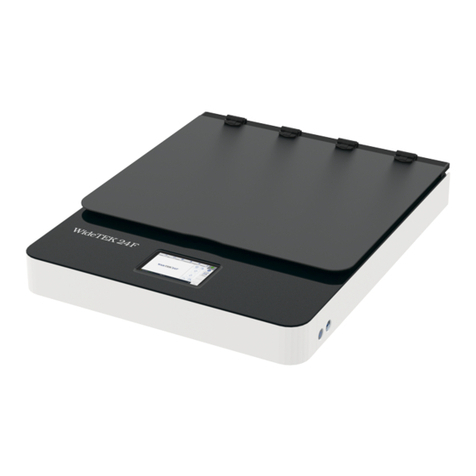
Image Access
Image Access WideTEK 24F Setup instructions

Fujitsu
Fujitsu fi-5530C - Document Scanner Getting started

